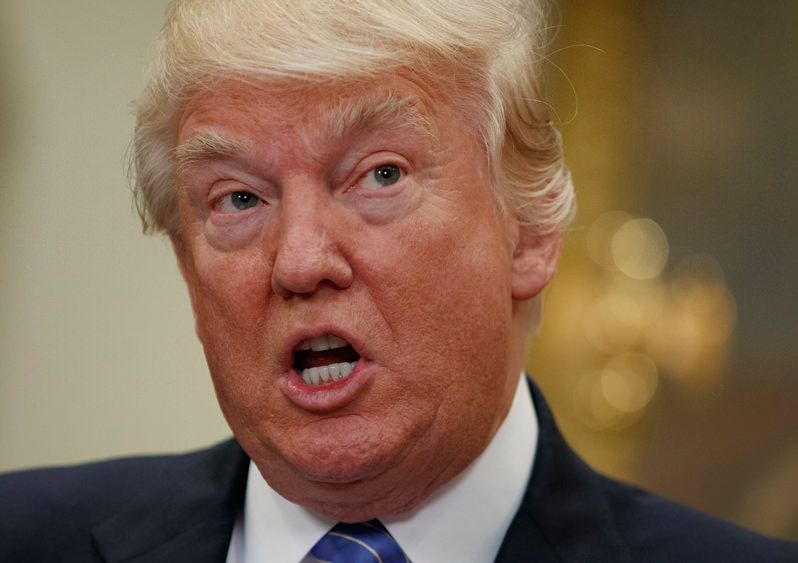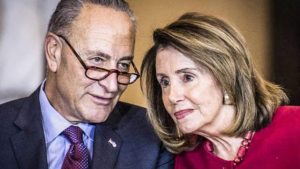No Anti-Immigrant Victory for Trump—So Far
The president lost big in Congress this week as Republicans and Democrats rejected his budget cuts for now, including those directed at immigrants. President Donald Trump. (Evan Vucci / AP)
President Donald Trump. (Evan Vucci / AP)
Editor’s note: The story of America is the story of immigrants. But since Donald Trump became president, the immigration issue has become a humanitarian crisis in the United States. Truthdig political correspondent Bill Boyarsky investigates the impact of Trump’s anti-immigrant racism on Los Angeles—home to 1 million undocumented immigrants—in this ongoing series for Truthdig called “Demonizing the City of Angels.” You can read all of Boyarsky’s stories in the series here.
President Donald Trump is not only a blowhard, he’s full of hot air. He proved that again this week when, after incessant boasting about “winning,” he lost big in Congress, where Republicans and Democrats—for the time being—rejected his budget cuts, including those directed at immigrants.
Congressional leaders announced Monday they had agreed on an interim budget plan that will keep the government running until Sept. 30. A final vote is expected before then.
Gone were Trump’s most highly touted proposals. The agreement preserves funding for Planned Parenthood, scientific research and the arts, all subjects of attacks by Trump and the Republican right. There also are no drastic cuts for the Environmental Protection Agency in the compromise.
Gone, too, is the heart of Trump’s anti-immigrant plan, including funding for the border wall and the elimination of federal funds for so-called sanctuary jurisdictions. These are cities, counties and states that won’t work as an extension of federal immigration enforcement. Also eliminated is money for a deportation force of more Immigration and Customs Enforcement cops to roam through the country searching for undocumented immigrants.
All the proposed cuts, including those threatening Planned Parenthood, reflect conservative Republican doctrine. None was as dangerous to democracy or as harmful to the poor—immigrants and non-immigrants alike—as those stemming from Trump’s racially tinged immigration policies.
It’s something I am conscious of every day, living in Southern California with its large and growing population of immigrants from Mexico, Central America, the Middle East and Asia. Walking along the streets, shopping, taking the commuter train, interviewing people for stories, seeing friends, going to Dodgers games or visiting university and college campuses, I see how immigration is continuing to change the United States for the better. Immigrants’ energy and talent, as well as the resistance they encounter, add up to a powerful story, one of the most significant I’ve ever covered.
Trump announced his policy in an executive order Jan. 25. It would have greatly increased the number of immigration enforcement officers and enhanced their power. It would have banned federal funding for sanctuary jurisdictions: “In furtherance of this policy, the attorney general and the [Homeland Security] secretary, in their discretion and to the extent consistent with law, shall ensure that … [sanctuary jurisdictions] are not eligible to receive federal grants, except as deemed necessary for law enforcement purposes.”
The term “sanctuary city” is vague. Kaiser Health News, in an article on the Trump order, said, “[T]he term ‘sanctuary cities’ describes locales—cities, but also states, counties and other community entities” that decline to do the work of federal immigration authorities. Such jurisdictions often forbid local police from inquiring about the immigration status of victims, suspects or witnesses. In some cases, local government officials are forbidden to ask the immigration status of those seeking medical help. “But there is no hard-and-fast definition of ‘sanctuary cities’ or federal delineation of which jurisdictions would be targeted …” the Kaiser article said.
What is certain is that, had Trump prevailed, billions of dollars in federal aid would have been denied to designated sanctuary jurisdictions. The federal government provides more than 30 percent of state revenue.
“These grants go to everybody,” Georges Benjamin, executive director of the American Public Health Association, told Kaiser Health News.
Under Trump’s plan, Los Angeles is highly likely to be designated a sanctuary city. Mayor Eric Garcetti has been a leader of the resistance to the Trump order. With that designation, the city could have lost $500 million a year, George Kivork, Garcetti’s press secretary, told me. About $100 million of that money goes for security at places such as the harbor and Los Angeles International Airport, which may be excluded from the order. But much of the rest helps the poor—immigrants and non-immigrants, including the city’s growing number of homeless people—with needs such as housing.
Reuters said an estimated $2.27 billion in federal funding for the 10 largest sanctuary cities would be at risk from the Trump order.
Santa Clara County, home of Silicon Valley, is one of the nation’s most affluent. But, like other localities, it is heavily dependent on federal funds. And because the county and its cities limit cooperation with federal immigration authorities, it would be a likely target for sanctuary designation.
The county receives about $1 billion annually in federal funds, roughly 15 percent of its budget. Santa Clara Valley Medical Center, which provides services to the poor and emergency care to everybody, receives 70 percent of its $1.4 billion budget from federal aid.
So far, the best defense against the Trump plan is an institution Trump despises: the federal courts—especially after they overturned his travel ban against Muslims.
In April, federal Judge William Orrick issued an injunction halting Trump’s sanctuary city order, affecting the entire nation. His ruling was on a suit brought by Santa Clara and San Francisco counties.
Orrick wrote: “The executive order threatens to deny sanctuary jurisdictions all federal grants, hundreds of millions of dollars on which the counties rely. The threat is unconstitutionally coercive.”
Local governments await the next rounds—a possible appeal of the judge’s order and a vote in Congress when the budget comes up again in September.
Trump tweeted Tuesday that he is willing to veto that bill and shut the government down. A destructive minority of the far right might support him, but many people would be hurt.
Before calling Trump a blowhard in this column, I looked up the term in the always-engaging Urban Dictionary. It defines the word as a “self important egomaniac that likes to toot his own horn.”
We’ll find out if the egomaniacal Trump is so wrapped up in himself, so intent on tooting his own horn, so anti-immigrant that he’s willing to bring government to a crawl, if not a stop, in pursuit of a victory that has, so far, been denied to him.
Your support matters…Independent journalism is under threat and overshadowed by heavily funded mainstream media.
You can help level the playing field. Become a member.
Your tax-deductible contribution keeps us digging beneath the headlines to give you thought-provoking, investigative reporting and analysis that unearths what's really happening- without compromise.
Give today to support our courageous, independent journalists.






You need to be a supporter to comment.
There are currently no responses to this article.
Be the first to respond.